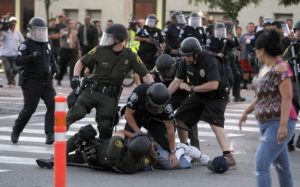Over the last nine months, our country has lurched from crisis to crisis concerning police/community relations and police use of force: from Ferguson, Missouri, to New York City, to Cleveland, to North Charleston, South Carolina, to Tulsa, Oklahoma, and now Baltimore. Each time, we hear pledges of police department reform.
This raises a question: What does a good police department look like? What are the best police practices in the second decade of the 21st century?
Here are 10 characteristics of a well-run police operation:
• Partnership: The most fundamental aspect of successful modern policing is cooperation between police and the communities they serve. The police cannot be everywhere. They need public support — especially information about what goes on in a neighborhood when they’re not there. Effective crime fighting requires trust between police and the people they serve. This takes years to build, but there is no substitute for it.
• Identifying with the community: A police department should resemble the community it serves with regard to race, ethnicity and gender, which allows it to more easily gain the trust and support of that community. Appropriate diversity does not by itself produce a well-functioning department. But a department that appears to exclude some groups, particularly when it consists almost entirely of white officers in majority black areas, will not earn the confidence of its community.
• Focused deterrence against violence: We have seen tremendous progress over the past 20 years in reducing crime, but crime rates have not fallen everywhere. Some neighborhoods have become safer than ever, while others continue to see people gunned down in the street. Recent research points to one promising strategy: focused deterrence. Police departments analyze mountains of data to identify the small number of individuals most likely to commit deadly violence. They then use all available criminal justice levers (for instance, searches based on parole or probation status) to head off violence before it starts.
• A modern use-of-force policy: Such a policy makes de-escalation of confrontations a priority and gives officers clear and reasonably detailed guidance on when and how much force to use in any given scenario — keeping in mind that officers face highly varied and often fast-developing situations. The policy should address all levels of force — from “come along” holds (the use of hands to bring a person into custody or walk the person toward a police vehicle), to the use of less-lethal weapons (such as pepper spray or Tasers), to the use of firearms. The policy should prohibit strikes to the head and state that officers may use only the minimal amount of force necessary to overcome a suspect’s resistance in pursuit of a lawful police purpose. A policy that simply says officers may use the amount of force that is “reasonably necessary” correctly reflects the law but is far too general to provide day-to-day guidance.
• Bias-free policing: Bias, conscious and unconscious, 
• Early Intervention Systems: EIS databases track multiple aspects of individual police officer behavior — everything from arrests, to citizen complaints, to missed court appearances. This tracking helps identify officers who exhibit more performance problems than other officers. When the EIS flags an officer, the department can intervene with re-training or counseling to try to prevent problems from growing into actions that may put the public at risk.
• An open and accessible citizen complaint process: Such a process should make it easy and non-threatening for citizens to file a complaint. It should be possible to file complaints in a variety of ways and locations and in any language spoken in the jurisdiction. It may seem strange to say that a police department should welcome complaints; after all, some will prove unfounded. But citizen complaints are one of the few ways that departments can learn whether they have systemic problems or issues with a particular officer. Complaints are customer data — something private industry understands well — that allow an organization to improve.
• Independent external oversight: There may be nothing more critical to police accountability than external oversight. Police have long bristled at the idea that civilians who have not served in law enforcement should sit in judgment of them. But in almost any government context, few people trust those in charge to oversee themselves. We can trace the idea back at least to Socrates, who asked, “Who will guard the guards themselves?” It is not that the public necessarily distrusts police; rather, it is that full public confidence requires outside perspective. Many models of independent oversight exist: citizen review boards, police monitors or auditors, and inspectors general, for example. All function a bit differently. One is not necessarily better than others, but every city with a police department should have one.
• Critical incident review: Any organization with grave responsibilities must learn from its mistakes. To improve its chances of accomplishing missions with the fewest deaths and injuries, the military has always performed after-action or lessons-learned reviews. Police departments need a formal process, separate from other investigation mechanisms, to review every critical incident — shootings or deaths in custody, for example.
• Policies made public: “Transparency” seems a mantra of modern government. Some public agencies talk a better game than they play, but increasing openness has become inevitable. Police departments have joined this movement reluctantly or not at all. The concern seems rooted in officer safety: If the bad guys know when officers will or will not use force, they may gain an advantage. When police policy and procedure are hidden, however, the public naturally becomes suspicious when something goes wrong and an official announces that no officer violated policy. All department policies should be posted on a website for every member of the public to see. A well-run police department has nothing to fear from making public its policies.
As Americans scrutinize police departments more carefully than ever before, these measures become ever more critical. When a department has a terrible incident and the U.S. Department of Justice investigates, these are the practices the feds should and will be looking for. Responsible departments understand that.
More importantly, responsible departments understand that modern policies and practices will help them do their job — protect their fellow citizens by preventing and reducing crime.
David A. Harris is distinguished faculty scholar and professor of law at the University of Pittsburgh, where he focuses on police behavior and criminal law and procedure.



